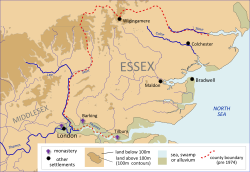Kingdom of Essex
The Kingdom of the East Saxons (Old English: Ēast Seaxna Rīce), was also called the Kingdom of Essex. It was one of the seven kingdoms of the Anglo-Saxon Heptarchy. Essex was founded in the 6th century. The kingdom of Essex covered the area of the modern English counties of Essex, Hertfordshire, Middlesex and (for a short while) Kent. Kings of Essex frequently found themselves under the control of other Anglo-Saxon overlords. The territory of the East Saxons included the two Roman provincial capitals of Colchester and, for a time, London. In the Tribal Hidage the East Saxons were listed at 7,000 hides.
Kingdom of the East Saxons | |||||||||
|---|---|---|---|---|---|---|---|---|---|
| 527–825 | |||||||||
 The Kingdom of Essex. | |||||||||
| Capital | London | ||||||||
| Common languages | Old English, Latin | ||||||||
| Religion | Anglo-Saxon paganism, Christianity | ||||||||
| Government | Monarchy | ||||||||
| King | |||||||||
• 527–587 | Æscwine (first) | ||||||||
• 798–825 | Sigered (last) | ||||||||
| Legislature | Witenagemot | ||||||||
| Historical era | Heptarchy | ||||||||
• Established | 527 | ||||||||
• Disestablished | 825 | ||||||||
| Currency | Sceat | ||||||||
| |||||||||
History
changeWhen they arrived in England the Saxons, like the Angles, Jutes and Frisians, were Pagans. After the Saxons gained control of Kent they set themselves up in the territory of Essex.[1] The first attempts to convert the East Saxons to Christianity came in 604 with the arrival of Bishop (later Saint) Mellitus in London.[2] Athelberht (King of Kent was the overlord of southern England and helped in the conversion of King Saebert of Essex.[a][3] Athelberht built and endowed St. Pauls in London, where St. Paul’s Cathedral now stands. After the death of Saebert in 616, Mellitus was driven out and the kingdom reverted to paganism.[4] King Oswi of Northumbria convinced King Sigebert of Essex to become Christian.[5] Sigebert then invited Chad to become Bishop of London. By 874 the Great Heathen Army held much of Essex.[5] They established bases from which they attacked other parts of England. In 825 the kingdom of the East Saxons became part of Wessex.[6]
Kings of Essex
change- Aescwine (legendary king)[b]
- Sledda (legendary king)[b]
- Saebert (c. 600–c. 616) - Son of Sledda, nephew of Athelbert of Kent[7]
- Sexred (c. 616–623) - Son of Saebert, ruled jointly with his two brothers Saeward and Sexbald.[7]
- Saeward (c. 616–623)[7]
- Sexbald (c. 616–623)[7]
- Sigebert I (623–c. 650) - Probable son of Saeward[7]
- Sigebert II (c. 650–c. 653) - Possible cousin of Sigebert I[7]
- Swithelm (c. 653–663)[7]
- Sigehere (ruled Essex 663–688; Kent 687–688)[7]
- Sebbi (663–693)[7]
- Sigeheard (693–c. 707) - Son of Sebbi[c][7]
- Swaefred (689–c. 707) - Son of Sebbi[c][7]
- Offa (707–709) - Son of Sigehere[7]
- Saelred (c. 709–746) Co-king[7]
- Swebert (709–738) Co-king[7]
- Swithred (746–759)[7]
- Sigeric (759–798)[7]
- Sigered (798–825) last king of Essex; reduced in rank after 811 to an ealdorman.[7]
Notes
changeReferences
change- ↑ Elizabeth Ogborne, The History of Essex: From the Earliest Period to the Present Time (London: Longman, Hurst, Rees, Orme & Browne, 1817), p. 5
- ↑ Bede, Ecclesiastical History of the English People, trans. Leo Sherley Price, revsd. R. E. Latham (London; New York: Penguin, 1990), p. 90
- ↑ Frank Stenton, Anglo-Saxon England (Oxford: Oxford University Press, 1971), p. 109
- ↑ Frank Stenton, Anglo-Saxon England (Oxford: Oxford University Press, 1971), p. 112
- ↑ 5.0 5.1 Elizabeth Ogborne, The History of Essex: From the Earliest Period to the Present Time (London: Longman, Hurst, Rees, Orme & Browne, 1817), p. 6
- ↑ D. P. Kirby, The Earliest English Kings, Revised Edition (London; New York: Routledge, 2000), p. 155
- ↑ 7.00 7.01 7.02 7.03 7.04 7.05 7.06 7.07 7.08 7.09 7.10 7.11 7.12 7.13 7.14 7.15 7.16 Mike Ashley, The Mammoth Book of British Kings and Queens (New york: Carroll & Graf, 1999), pp. 233–237
Other websites
change- Kingdom of Essex Archived 2014-07-04 at the Wayback Machine